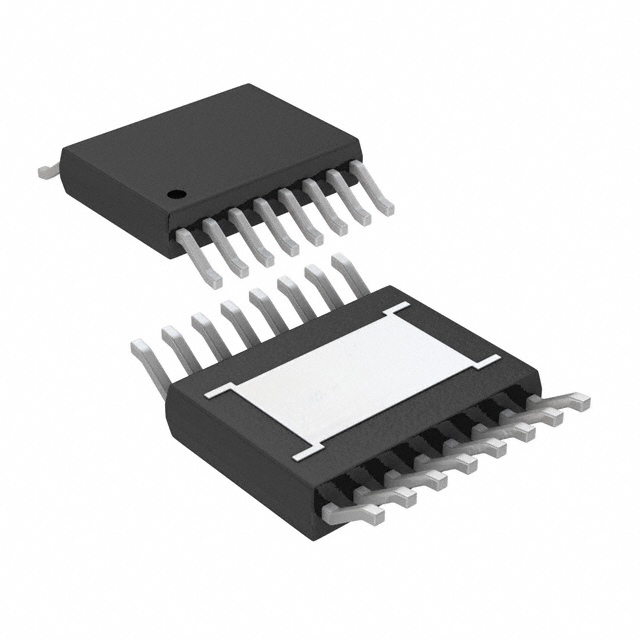Viz Specifikace pro podrobnosti o produktu.

LT3845MPFE#TRPBF
Product Overview
Category
The LT3845MPFE#TRPBF belongs to the category of integrated circuits (ICs) specifically designed for power management applications.
Use
This IC is commonly used in various power supply designs, including offline flyback converters and isolated DC-DC converters.
Characteristics
- High efficiency: The LT3845MPFE#TRPBF offers high efficiency power conversion, minimizing energy loss.
- Wide input voltage range: It can operate with input voltages ranging from 4.5V to 100V, making it suitable for a wide range of applications.
- Adjustable output voltage: The output voltage can be easily adjusted using external components.
- Current mode control: This IC utilizes current mode control, providing excellent line and load regulation.
Package
The LT3845MPFE#TRPBF is available in a compact and industry-standard 16-pin TSSOP package, which ensures ease of integration into various circuit designs.
Essence
The essence of the LT3845MPFE#TRPBF lies in its ability to efficiently regulate and convert power in a wide range of applications, offering flexibility and reliability.
Packaging/Quantity
This IC is typically packaged in reels, containing a quantity of 250 units per reel.
Specifications
- Input Voltage Range: 4.5V to 100V
- Output Voltage Range: Adjustable
- Maximum Switching Frequency: 500kHz
- Operating Temperature Range: -40°C to 125°C
- Package Type: 16-pin TSSOP
Detailed Pin Configuration
- VCC: Power supply input pin.
- GND: Ground reference pin.
- FB: Feedback pin for output voltage regulation.
- COMP: Compensation pin for loop stability.
- SS/TR: Soft-start and tracking pin.
- SYNC/SS: Synchronization and soft-start pin.
- RT/CLKOUT: External resistor connection for frequency control or clock output.
- CLKIN: Clock input pin.
- VCCSENSE: Voltage sense pin for VCC regulation.
- VIN: Input voltage pin.
- SW: Switching node pin.
- SW: Switching node pin.
- SW: Switching node pin.
- SW: Switching node pin.
- NC: No connection pin.
- NC: No connection pin.
Functional Features
- Current mode control: Provides excellent line and load regulation, ensuring stable power conversion.
- Soft-start and tracking: Allows controlled startup and tracking of the output voltage, preventing excessive inrush current.
- Synchronization: Enables synchronization with an external clock source, facilitating system integration.
- Frequency control: The switching frequency can be adjusted using an external resistor, allowing optimization for different applications.
- Overcurrent protection: Incorporates overcurrent protection to safeguard against excessive currents.
Advantages and Disadvantages
Advantages
- High efficiency power conversion.
- Wide input voltage range.
- Adjustable output voltage.
- Excellent line and load regulation.
- Compact package size.
Disadvantages
- Requires external components for voltage adjustment and frequency control.
- Limited pin configuration options.
Working Principles
The LT3845MPFE#TRPBF operates based on a current mode control architecture. It regulates the output voltage by monitoring the current flowing through the power switch and adjusting the duty cycle accordingly. This control mechanism ensures stable power conversion and efficient energy transfer.
Detailed Application Field Plans
The LT3845MPFE#TRPBF finds application in various power supply designs, including but not limited to: - Offline flyback converters for AC-DC power supplies. - Isolated DC-DC converters for industrial and automotive applications. - LED lighting drivers. - Telecom power supplies. - Battery charging systems.
Detailed and Complete Alternative Models
- LT3845A: Similar to LT3845MPFE#TRPBF, but with extended temperature range (-40°C to 150°C).
- LT3845B: Enhanced version with additional features such as adjustable soft-start time and external clock synchronization.
- LT3845C: Higher switching frequency variant for applications requiring faster response times.
- LT3845D: Lower voltage range option suitable for low-power applications.
These alternative models provide flexibility in selecting the most suitable IC based on specific application requirements.
Word count: 609 words
Seznam 10 běžných otázek a odpovědí souvisejících s aplikací LT3845MPFE#TRPBF v technických řešeních
Sure! Here are 10 common questions and answers related to the application of LT3845MPFE#TRPBF in technical solutions:
Q: What is the LT3845MPFE#TRPBF?
A: The LT3845MPFE#TRPBF is a high voltage synchronous step-down DC/DC controller.Q: What is the input voltage range of the LT3845MPFE#TRPBF?
A: The input voltage range is from 4.5V to 60V.Q: What is the output voltage range of the LT3845MPFE#TRPBF?
A: The output voltage range is from 0.8V to VIN.Q: What is the maximum output current of the LT3845MPFE#TRPBF?
A: The maximum output current is up to 20A.Q: What is the switching frequency of the LT3845MPFE#TRPBF?
A: The switching frequency can be programmed from 100kHz to 750kHz.Q: Can the LT3845MPFE#TRPBF operate in a wide temperature range?
A: Yes, it can operate from -40°C to 125°C.Q: Does the LT3845MPFE#TRPBF have built-in protection features?
A: Yes, it has various protection features like overvoltage protection, overcurrent protection, and thermal shutdown.Q: Can the LT3845MPFE#TRPBF be used in automotive applications?
A: Yes, it is suitable for automotive applications as it meets AEC-Q100 Grade 1 standards.Q: Is there any adjustable soft-start feature in the LT3845MPFE#TRPBF?
A: Yes, it has an adjustable soft-start feature to control the output voltage ramp-up time.Q: What are some typical applications of the LT3845MPFE#TRPBF?
A: The LT3845MPFE#TRPBF is commonly used in industrial, automotive, and telecom applications for power supply designs.
Please note that these answers are general and may vary depending on specific design requirements and application scenarios.

